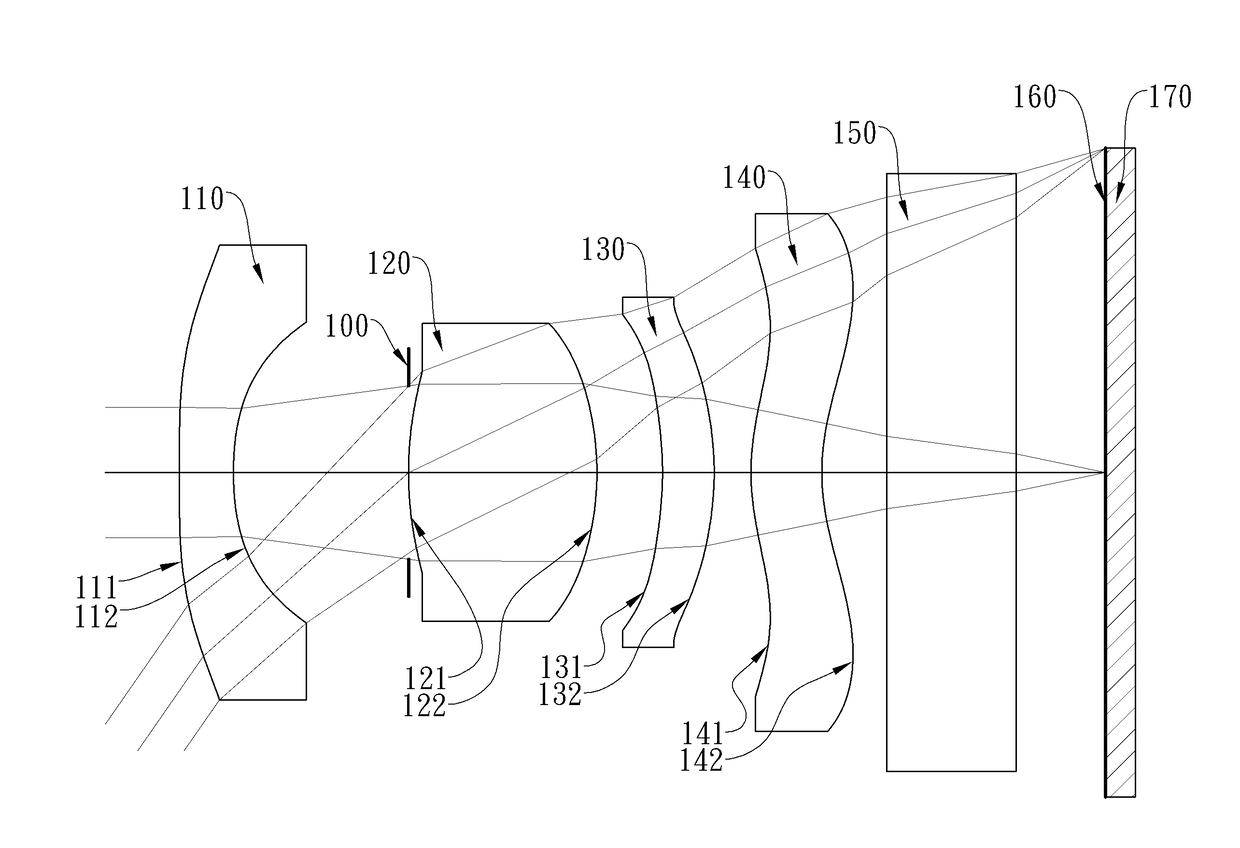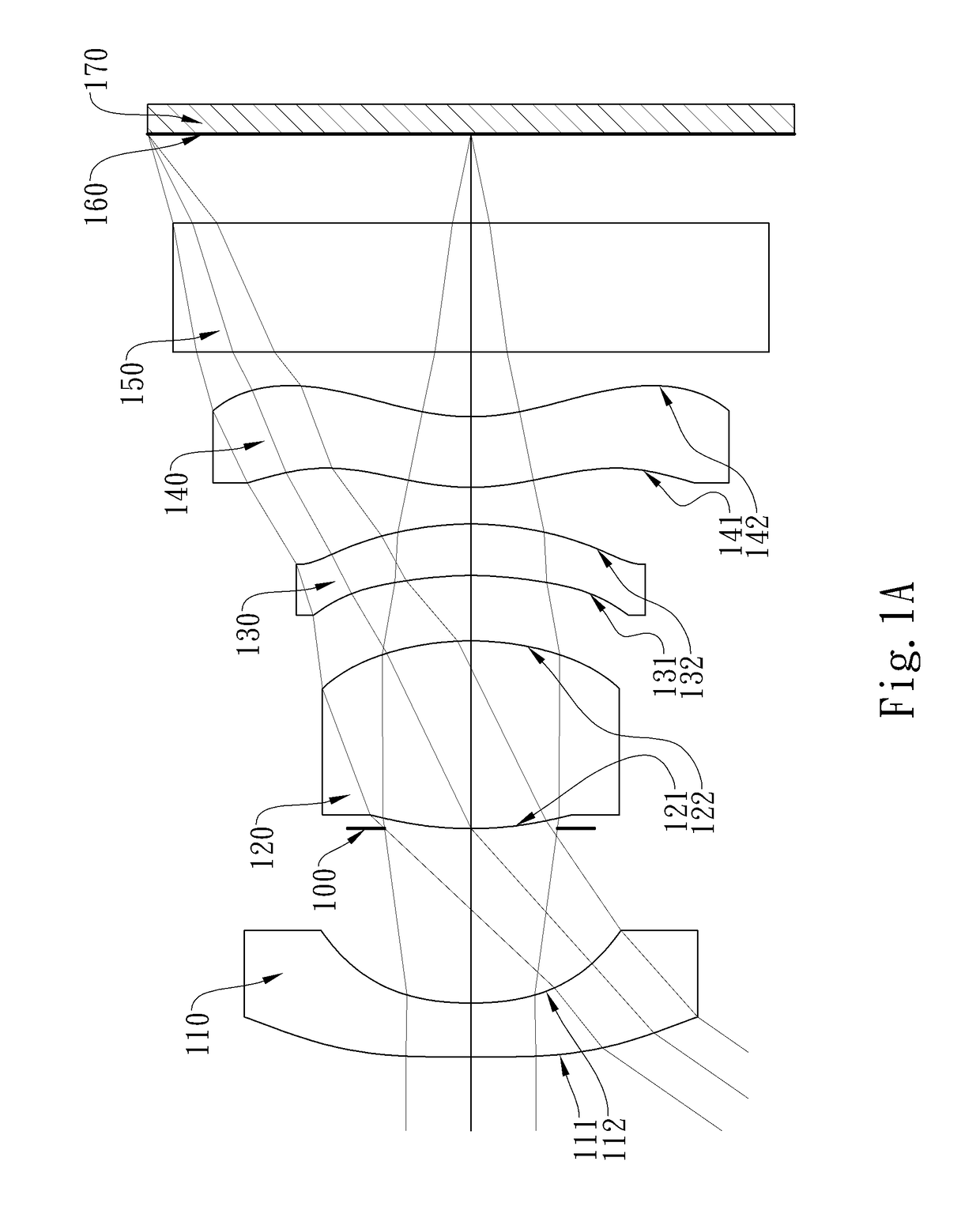Optical lens assembly, image capturing apparatus and electronic device
a technology of optical lens applied in the field of optical lens assembly and image capturing apparatus, can solve the problems of inability to reduce the size of the product equipped with the conventional lens assembly with inability to inability to concomitantly meet the requirements of a wide field of view, etc., to achieve the effect of effectively correcting the field curvature, reducing the angle, and smooth formation
- Summary
- Abstract
- Description
- Claims
- Application Information
AI Technical Summary
Benefits of technology
Problems solved by technology
Method used
Image
Examples
1st embodiment
[0068]FIG. 1A is a schematic view of an image capturing apparatus according to the 1st embodiment of the present disclosure. FIG. 1B shows, in order from left to right, longitudinal spherical aberration curves, astigmatic field curves and a distortion curve of the image capturing apparatus according to the 1st embodiment.
[0069]In FIG. 1A, the image capturing apparatus comprises an optical lens assembly (not otherwise herein labeled) of the present disclosure and an image sensor 170. The optical lens assembly comprises, in order from an object side to an image side, a first lens element 110, an aperture stop 100, a second lens element 120, a third lens element 130, and a fourth lens element 140.
[0070]The first lens element 110 with negative refractive power has an object-side surface 111 being convex in a paraxial region thereof and an image-side surface 112 being concave in a paraxial region thereof, which are both aspheric, and the first lens element 110 is made of plastic material...
2nd embodiment
[0101]FIG. 2A is a schematic view of an image capturing apparatus according to the 2nd embodiment of the present disclosure. FIG. 2B shows, in order from left to right, longitudinal spherical aberration curves, astigmatic field curves and a distortion curve of the image capturing apparatus according to the 2nd embodiment.
[0102]In FIG. 2A, the image capturing apparatus comprises an optical lens assembly (not otherwise herein labeled) of the present disclosure and an image sensor 270. The optical lens assembly comprises, in order from an object side to an image side, a first lens element 210, an aperture stop 200, a second lens element 220, a third lens element 230, and a fourth lens element 240.
[0103]The first lens element 210 with negative refractive power has an object-side surface 211 being convex in a paraxial region thereof and an image-side surface 212 being concave in a paraxial region thereof, which are both aspheric, and the first lens element 210 is made of plastic material...
3rd embodiment
[0111]FIG. 3A is a schematic view of an image capturing apparatus according to the 3rd embodiment of the present disclosure. FIG. 3B shows, in order from left to right, longitudinal spherical aberration curves, astigmatic field curves and a distortion curve of the image capturing apparatus according to the 3rd embodiment.
[0112]In FIG. 3A, the image capturing apparatus comprises an optical lens assembly (not otherwise herein labeled) of the present disclosure and an image sensor 370. The optical lens assembly comprises, in order from an object side to an image side, a first lens element 310, an aperture stop 300, a second lens element 320, a third lens element 330, and a fourth lens element 340.
[0113]The first lens element 310 with negative refractive power has an object-side surface 311 being convex in a paraxial region thereof and an image-side surface 312 being concave in a paraxial region thereof, which are both aspheric, and the first lens element 310 is made of plastic material...
PUM
 Login to View More
Login to View More Abstract
Description
Claims
Application Information
 Login to View More
Login to View More - R&D Engineer
- R&D Manager
- IP Professional
- Industry Leading Data Capabilities
- Powerful AI technology
- Patent DNA Extraction
Browse by: Latest US Patents, China's latest patents, Technical Efficacy Thesaurus, Application Domain, Technology Topic, Popular Technical Reports.
© 2024 PatSnap. All rights reserved.Legal|Privacy policy|Modern Slavery Act Transparency Statement|Sitemap|About US| Contact US: help@patsnap.com










